
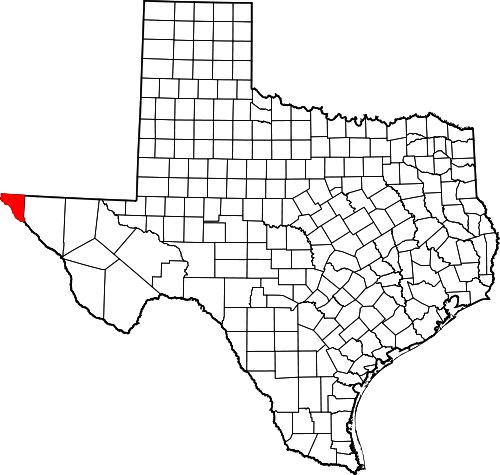 As the sixth largest county in the state of Texas, El Paso County shares approximately 47 miles of its southern border with Mexico. The U.S. Census estimates El Paso County’s population at 840,758 residents with about 682,669 living in the city of El Paso. The city is contiguous with Juarez, Mexico; the two municipalities together make up a metropolitan area known as the “Borderplex.” The El Paso County Sheriff’s Department and the El Paso Police Department are the most notable law enforcement agencies in the county
As the sixth largest county in the state of Texas, El Paso County shares approximately 47 miles of its southern border with Mexico. The U.S. Census estimates El Paso County’s population at 840,758 residents with about 682,669 living in the city of El Paso. The city is contiguous with Juarez, Mexico; the two municipalities together make up a metropolitan area known as the “Borderplex.” The El Paso County Sheriff’s Department and the El Paso Police Department are the most notable law enforcement agencies in the county
Law enforcement in the region deploy various types of surveillance technologies, including drones, body-worn cameras, and automated license license plate readers. The federal government also keeps a close eye on the border region with technologies that include automated license plate readers, sensor towers, drones, and surveillance balloons.
Quick links:
- Automated license plate readers
- Iris scanning
- Drones
- Body-worn cameras
- Fusion center: Matrix
- Face recognition
- Spy planes
- Operation Drawbridge
- Federal surveillance technologies
Automated License Plate Readers
Automated license plate readers (ALPRs) are networks of cameras used to track the movements of vehicles. Police attach cameras to patrol cars or fixed locations, like highway overpasses, to amass a searchable database that can reveal a driver’s movement. Police may also add license plates to a “hot list” to get real-time alerts whenever the vehicle is photographed by an ALPR.
According to Texas A&M Transportation Institute, the El Paso Police Department has used ALPR technology since 2006. As of 2012, the agency operated 23 mobile ALPR units and owns six ALPR-equipped trailers that can be parked along any roadway. These trailers include a radar system and a “Your Speed Is:” display. Horizon City also has one ALPR-equipped patrol car as of 2012 and feeds the data it collects in to EPPD’s database.
Federal agencies actively use ALPRs in the region, including the U.S. Drug Enforcement Administration and U.S. Customs and Border Protection.
For more information:
Learn more about automated license plate readers.
Iris Scanning
Iris Scanning is a form of biometric technology that uses both visible and infrared light to take a high-contrast image of a person’s iris. Like fingerprints, irises are unique to an individual and can be used to identify individuals in a designated system.
The El Paso County Sheriff’s Office received three new cameras with iris scanning from BI2 Technologies in June 2017, according to KFOX14. As of April 2018, deputies have used iris scanning while booking more 18,000 inmates. The sheriff’s office was able to purchase these cameras through a $10,000 grant from the National Sheriff’s Association.
For more information:
- SecureIDNews: El Paso sheriff to use iris scanners
- KFOX14: Doña Ana County to receive iris-scanning technology
Learn more about iris scanning.
Drones
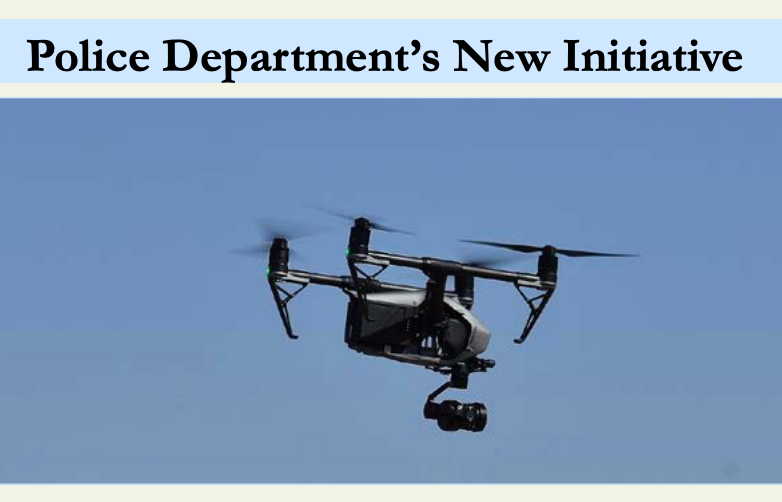
El Paso Police Department drone. Source: EPPD Annual Report 2018
Drones are remote-controlled vehicles that police use for aerial surveillance. Local agencies generally use compact, less expensive drones known as small unmanned aerial systems (sUAS) or quadrotors, as opposed to the larger systems deployed by the military and the U.S. Department of Homeland Security.
The El Paso Police Department has a drone unit consisting of four certified pilots and four drones, according to the agency’s 2018 annual report. The El Paso Fire Department also has two drones that it uses in rescue missions, according to KFOX14.
For more information:
Body-Worn Cameras

El Paso Police Department's body-worn cameras. Source: EPPD presentation to El Paso City Council
Body-worn cameras (BWCs) are small devices affixed to an officer’s uniform that capture video and audio of the officer’s encounters with the public. Often billed as a measure to enhance police accountability, BWCs also function as a mobile police surveillance network.
The El Paso Police Department outfits its Crisis Intervention Team and DWI Task Force with body-worn cameras. As of April 2019, the police department had 34 Vista WatchGuard BWCs and stores the footage on a city server for at least 180 days.
In December 2015, the El Paso Independent School District equipped all 43 of their school liaison police officers with MUVI body-worn cameras. The camera has a flap that hides the lens when it is off, but the officer can lower the lens to start recording an interaction with a student. The footage taken is stored in an internal storage system that is part of the district’s information technology department.
As of December 2017, the El Paso County Sheriff’s Department carries at least 250 Axon BWCs. The Horizon City Police Department and the Socorro Police Department use BWCs as well.
For more information:
- GovTech:Police Union Pushes Back on Body Cameras in El Paso, Texas
- GovTech: School District’s Use of Police Body Cameras Requires a Delicate Balance
- El Paso Police Department: Body Worn Camera Project
Learn more about body-worn cameras.
Fusion Center: MATRIX
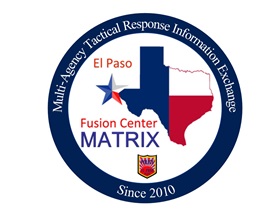
The Multi Agency Tactical Response Information eXchange (MATRIX) is one of 79 federally-designated “fusion centers” nationwide that conduct large-scale intelligence analysis and information sharing between local, state, and federal agencies. Based in El Paso, MATRIX allows officers from 20 public safety agencies in El Paso County and Doña Ana County to access and analyze records consolidated from a variety of information sources. In addition, the center also has access to certain surveillance cameras throughout the region, according to the MATRIX’s 2012 privacy policy. MATRIX analysts also generate tips and leads for investigators known as “Suspicious Activity Reports.”
For more information:
Face Recognition
The Texas Department of Public Safety (DPS) has used face recognition since 2005. A 2015 study by the Center on Privacy & Technology at Georgetown Law found that DPS can search 24-million driver license and ID photos and 24.9-million mug shots in the FBI’s Next Generation Identification Interstate Photos System. Texas DPS accepts search requests from both local and federal law enforcement agencies.
For more information:
Learn more about face recognition.
Texas Spy Planes
Privacy Information
This map will serve content from arcgis.com, a third-party host, which may restrict access for users on Tor or users with third-party cookies blocked. The map requires use of Javascript and is subject to the ArcGIS Privacy Policy.
If you're having trouble viewing the map, you can Search the Data instead.
Map showing Texas Department of Public Safety spy plane flight courses. Source: Texas Observer
As part of a program called Operation Secure Texas, the Texas Department of Public Safety (DPS) has spent more than $15 million on two high altitude surveillance planes that fly more than two miles above the Earth. The Texas Observer found that from January 2015 to July 2017, DPS flew these planes above El Paso County at least six times for purposes such as patrolling the border and to transfer an inmate accused of murder.
For more information:
Operation Drawbridge
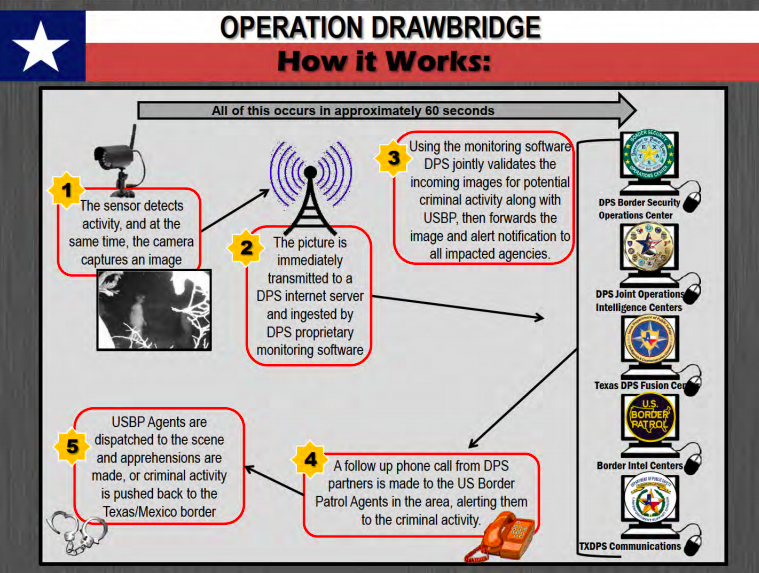
Operation Drawbridge flowchart. Source: Texas Department of Public Safety
The Texas Department of Public Safety has installed hundreds of cameras in border areas through a program called Operation Drawbridge. The $300 cameras are designed for capturing wildlife, but have been repurposed to photograph human movements. The low-light capable, motion-triggered cameras are monitored around the clock by the Texas Fusion Center, the Texas Border Security Operations Center, DPS Communications facilities, and U.S. Border Patrol Facilities. Texas DPS claims the cameras have been used to apprehend 250,000 individuals and the seizure of 248 tons of marijuana as of January 2019.
For more information:
Federal Surveillance Technologies

Customs & Border Protection aerostat in Marfa, Texas. Source: CBP Flickr
In addition to ALPRs, the U.S. Customs and Border Protection monitors the border using large MQ-9 Predator B drones and surveillance blimps called aerostats. These Tethered Aerostat Radar Systems (TARS) watch over the southern border from 10,000-feet in the air, and can detect all flying aircraft within 200 miles of the blimp. According to data published by the Government Accountability Office, between 2014 and 2016, these aerostats assisted in 13 apprehensions in the El Paso sector.
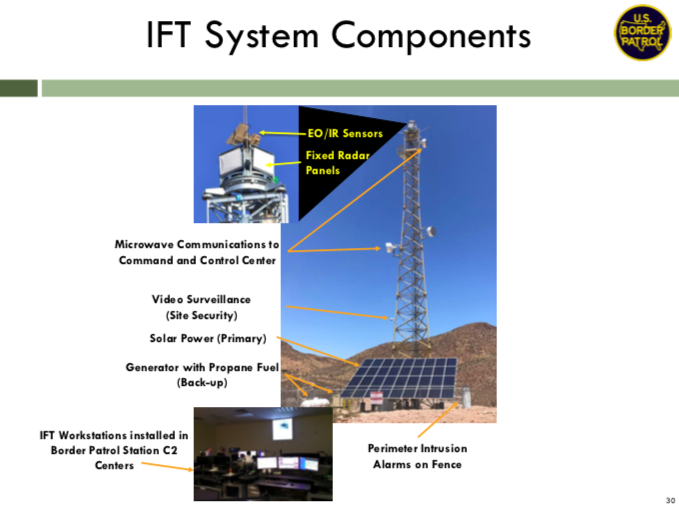
The components of an integrated fixed tower. Source: Border Patrol industry day presentation
According to the U.S. Border Patrol, El Paso County has 28 Integrated Fixed Tower System (IFT) deployment sites and 69 Remote Video Surveillance System (RVSS) deployment sites. IFT systems automatically detect and track items of interest. They also provide operators with data, video, and geospatial location of selected items of interest to identify and classify them. RVSS technology provides long- to short-range surveillance with cameras, radio, and microwave transmitters to send video to a control room for an operator to remotely detect, track, identify, and classify targets in the video feed.
For more information:



